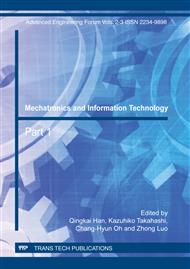p.1035
p.1041
p.1047
p.1051
p.1059
p.1067
p.1071
p.1077
p.1082
Non-Parametric Model of Magneto-Rheological (MR) Damper Based on Adaptive Neuro-Fuzzy Inference System (ANFIS)
Abstract:
Magneto-rheological (MR) damper is a typical non-linear actuator. The nonlinear relationship between the input and the output of MR damper should be characterized accurately in order to produce a required control action supplied by MR damper. The challenges of the conventional parametric model are the time-consuming and the requirement of complex parameter identification for MR damper. In this paper, a non-parametric model of MR damper based on the adaptive neuro-fuzzy system theory is presented to overcome the drawbacks of the conventional parametric model. This non-parametric model is developed by means of two adaptive neural fuzzy sub-systems which are designed to describe the nonlinear relationship in MR damper successfully. One sub-system is used to characterize the dependence of the damping force on velocity and acceleration, the other sub-system is used to characterize the dependence of the damping force level on the control voltage. The proposed non-parametric model is identified by experimental results. Furthermore, the accuracy of the model is investigated and evaluated. The model supplies a key technical support to achieve excellent control performances for semi-active suspension systems with MR dampers in vehicle.
Info:
Periodical:
Pages:
1059-1066
Citation:
Online since:
December 2011
Authors:
Permissions:
Share:
Citation:


